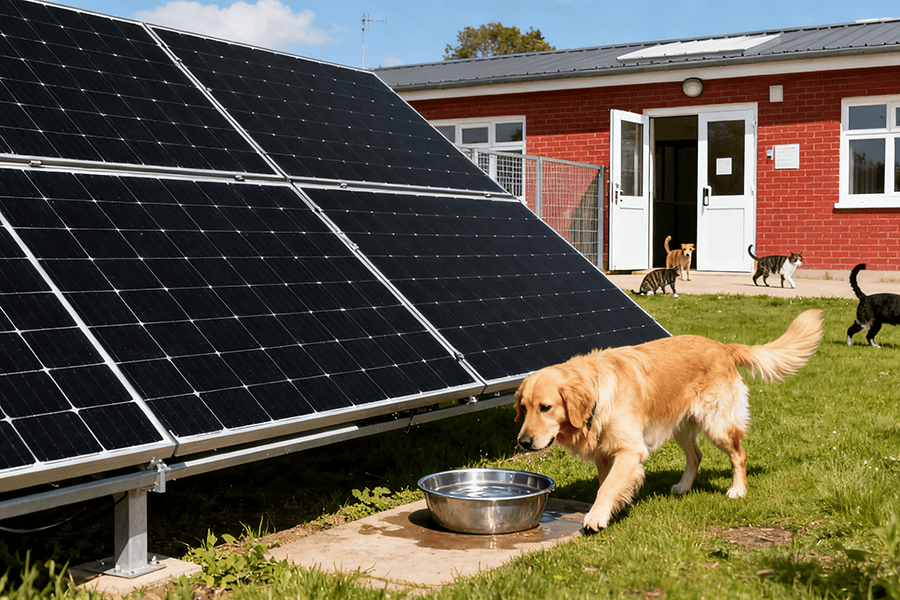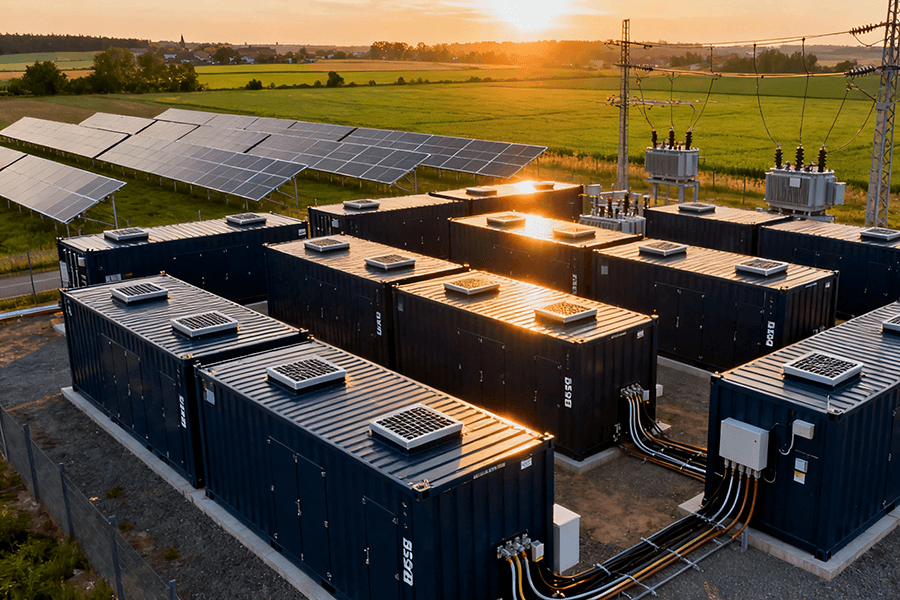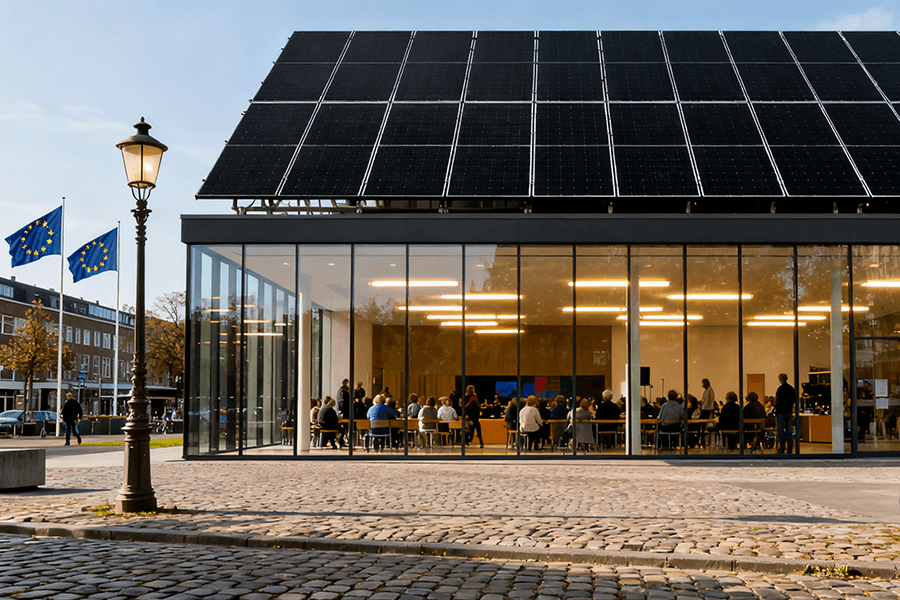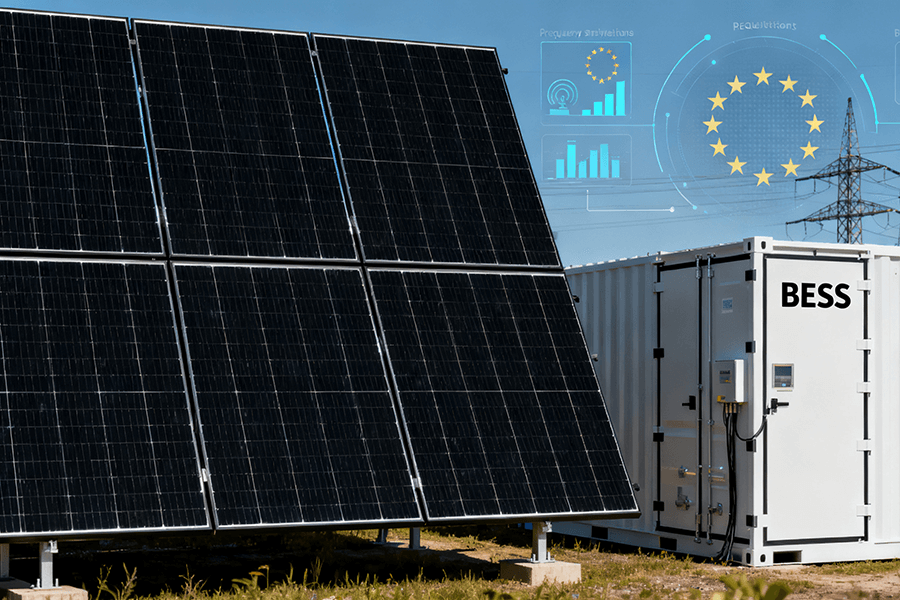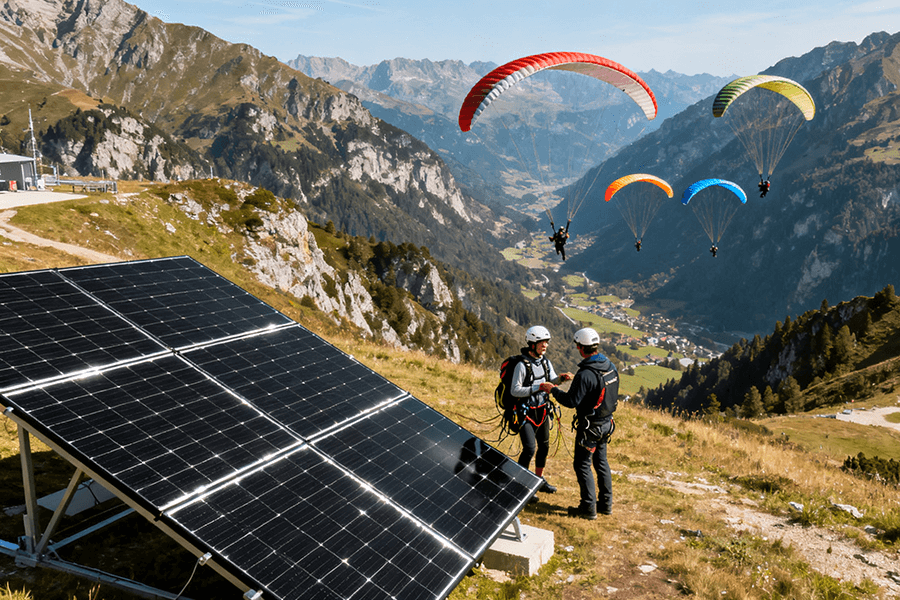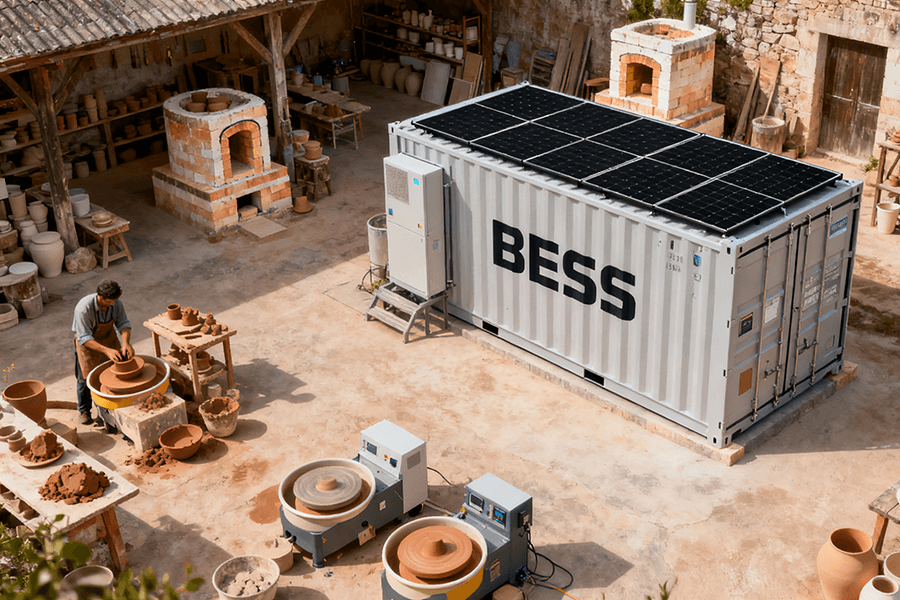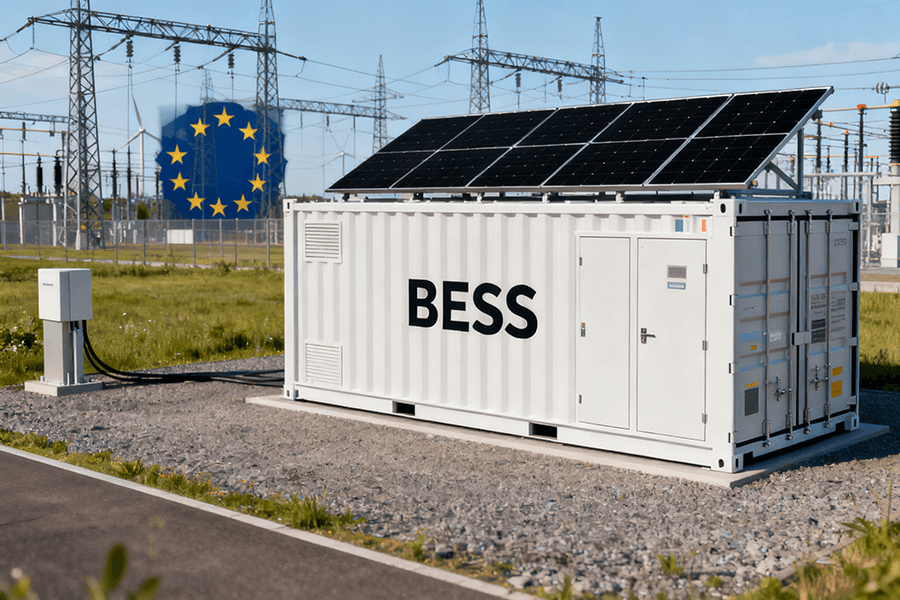
Introduction: The EU’s Grid “Inertia Crisis” – When Renewables Break the “Slow and Steady” Rule
Let’s start with a grid physics lesson your high school teacher skipped: grid inertia is the power system’s “resistance to panic.” Think of it like a spinning top—fossil fuel turbines (the old-school tops) keep spinning steadily, so frequency (the speed) barely wobbles. But wind and solar? They’re like plastic tops with no momentum—one cloud or gust, and frequency goes haywire faster than a tourist lost in a Greek island maze.
The Numbers That Matter
- EU’s 2030 renewable target: 42.5% (binding) (aspirations for 45%)
- Inertia loss rate: 8% drop per 10% fossil fuel retirement
- 2023 EU renewable penetration: 24.5% — inertia already at critical levels
If we keep retiring coal and gas plants without a backup, blackouts could become as common as rain in London. Enter the hero in a steel box: BESS containers with virtual inertia control. These aren’t just batteries—they’re “digital turbines” that mimic fossil fuel inertia in milliseconds. Let’s dive into how they save the day.
How BESS Containers Become “Digital Turbines” – Inertia on Demand
BESS containers don’t just store energy—they act like the grid’s stabilizing force. Using advanced algorithms (think: grid brain power), they detect frequency blips and adjust power output faster than you can say “renewable revolution.”
Fast Frequency Response: Stopping Frequency “Whiplash”
Fossil fuel plants take seconds to react to frequency changes. BESS containers? Milliseconds. Here’s the step-by-step magic:
- Detection: Sensors spot frequency shifts (e.g., from 50Hz to 49.8Hz) in under 50ms.
- Simulation: Control algorithms (like Virtual Synchronous Generators, VSG) adjust power output to “slow” the shift—mimicking a turbine’s rotational inertia.
- Stabilization: Power flows in/out to restore frequency before humans (or even grid computers) notice.
Real-World Win: Germany’s Grid Revival
Germany’s TSOs are leading the charge—they’ll launch inertia service tenders in 2026, with premiums for systems offering 90%+ availability . A 2024 pilot in northern Germany with 10MW of BESS containers delivered tangible results:
- Restored grid inertia to 2010 levels (pre-mass wind integration)
- Cut frequency deviation incidents by 45%
- Eliminated the need for 20MW of backup gas capacity
That’s like turning back the clock on grid stability—without burning a gram of coal.
Distributed Inertia: Saving Rural Grids from “Solar Shocks”
Big transmission grids get all the attention, but rural distribution grids (Swedish farms, Greek islands) are the most vulnerable. Wind and solar here are “flaky neighbors”—one cloudy day, and the grid teeters. Small-scale BESS containers (500kWh–2MWh) are the perfect fix: they provide localized inertia where it’s needed most.
Case Study: Greece’s “Digital Poseidon”
A Cycladic island swapped 4 diesel gensets (total 7.5MW) for a 5MW/25MWh BESS container from Maxbo Solar—and hit 98% renewable penetration. The upgrade was transformative:
|
Metric
|
Pre-2023 (Diesel Era)
|
2025 (Solar + BESS)
|
Change
|
Source
|
|
Annual Fuel Cost
|
€1.2M ($1.3M)
|
€48,000 ($52,000)
|
↓ 96%
|
Astypalea Project Report
|
|
CO₂ Emissions
|
4,800 Tonnes
|
96 Tonnes
|
↓ 98%
|
EU Emissions Monitoring
|
|
Grid Reliability
|
97.1%
|
99.97%
|
↑ 2.87%
|
Siemens Grid Analytics
|
|
Resident Energy Cost
|
€0.42/kWh
|
€0.18/kWh
|
↓ 57%
|
Hellenic Regulatory Auth.
|
Local fisherman Dimitrios Stavros summed it up: “Even Poseidon’s trident couldn’t pry our grid from that steel box now.”
Why BESS Containers Make Business Sense – Cash for Inertia
Let’s be real: no one deploys tech just to save the grid—there needs to be cash in it. Lucky for BESS operators, EU regulators and TSOs are opening their wallets for inertia.
Inertia Payment Mechanisms: Earn While Stabilizing
EU TSOs are rolling out inertia-specific revenue streams, turning grid stability into a profitable service.
|
Country/Region
|
Payment Rate
|
Key Terms
|
Launch Year
|
|
Germany
|
€18–25/kW/year
|
90% availability requirement
|
2026
|
|
Netherlands
|
€15–20/kW/year
|
Stackable with peak shaving
|
2024
|
|
UK
|
£12–18/kW/year
|
Tied to frequency response
|
2025
|
Example: A Dutch Fleet’s Double Win
A Dutch energy firm’s 50MW BESS fleet earns €1 million annually from inertia compensation—on top of €2.3 million from peak-shaving revenue. That’s like getting paid twice for the same battery: once for storing energy, once for keeping the grid calm.
Regulatory Mandates: No Inertia, No Grid Access
The EU’s Network Codes (updated 2019) mandate inertia reserves for renewable projects larger than 10MW. The 2023 revised Renewable Energy Directive goes further: grids must prove sufficient inertia to handle 42.5% renewables by 2030.
Regulatory Red Flags (and Opportunities)
- UK Rule: National Grid requires 20% of inertia reserves to come from BESS by 2028 . After a 2019 blackout affected 1.1 million users, the TSO confirmed BESS restored frequency 4x faster than gas plants .
- Port Pressure: Major ports (Rotterdam, Hamburg) face fines of €50k/day for failing to meet inertia standards—driving 200+ BESS deployments since 2024.
Maxbo Solar: Our BESS Containers – Built for EU Inertia
At Maxbo Solar, we’ve engineered BESS containers for EU grids since 2018—and we know inertia isn’t just a tech check: it’s a business necessity. Our systems are built to tick every TSO box, from millisecond response times to 95%+ availability.
Key Specs for Inertia Services
We offer two core models optimized for EU grid requirements, both using fire-safe LFP cells and VSG control:
|
Model
|
20ft Air-Cooled
|
40ft Air-Cooled
|
|
Capacity
|
200–600 kWh
|
600 kWh–2 MWh
|
|
Output Power
|
50–300 kW
|
250–630 kW
|
|
Response Time
|
< 100 ms
|
< 100 ms
|
|
Availability
|
95%+
|
95%+
|
|
Compliance
|
EU Network Codes, VDE
|
EU Network Codes, VDE
|
Source: Maxbo Solar ESS Specs
Our Greek Island Success
Our 5MW/25MWh liquid-cooled container (deployed 2023) is the “digital backbone” of a Cycladic island. It provides 100% of local inertia, replacing diesel gensets and cutting emissions by 98%. Local energy director Maria Kosta told us: “Maxbo’s container didn’t just fix the grid—it made renewables profitable.”
Why Choose Maxbo?
- Inertia-Ready: Our BMS is pre-certified by Germany’s TÜV and the UK’s National Grid.
- Fast Deployment: Plug-and-play design means installation in 2 weeks—critical for grids in crisis.
- Revenue Stacking: We optimize projects to earn from inertia, peak shaving, and backup power—delivering ROI in 3–5 years.
Learn more at www.maxbo-solar.com.
Conclusion: The Future – BESS Containers as Grid “Backbone”
By 2035, we predict BESS containers will provide 30% of European grid inertia—replacing retiring coal and gas plants. The case is airtight:
- Tech is Proven: BESS response times (ms) outpace fossil fuels (seconds) by 100x.
- Cash is Guaranteed: TSO payments and mandates create predictable revenue.
- EU Can’t Wait: To hit 45% renewables by 2030, inertia must be built into every project.
The EU’s green transition doesn’t have to mean a wobbly grid. With BESS containers—especially those engineered for inertia, like Maxbo’s—we can have it all: 100% renewables and a grid that stays calm.
Because when it comes to inertia, slow and steady wins the race—and BESS containers are the new tortoises.

